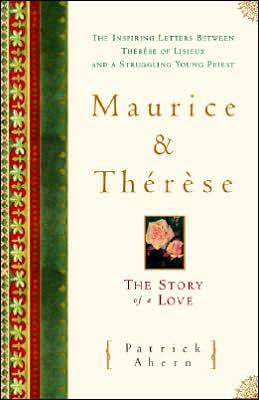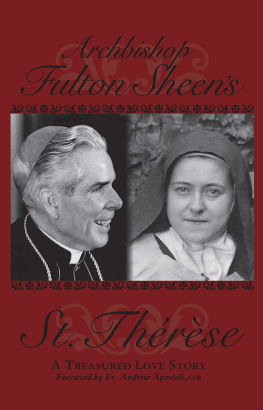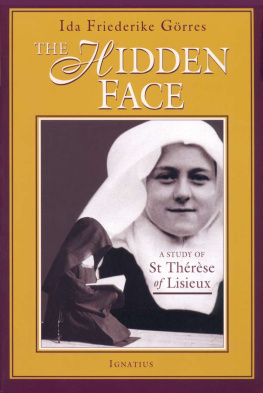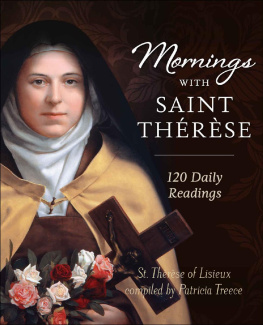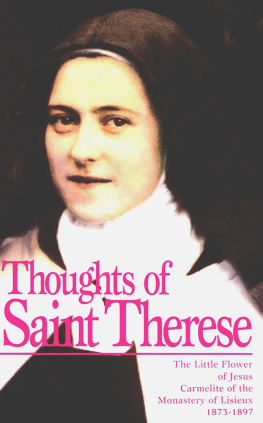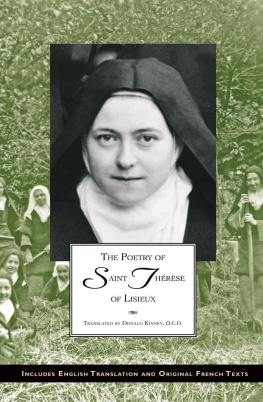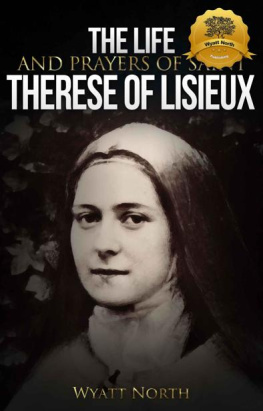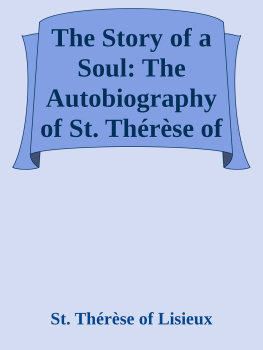MAURICEAND THRSE
The Story of a Love
by
Patrick Ahern

Published by Doubleday
A division of Bantam Doubleday DellPublishing Group, Inc.
1540 Broadway, New York, New York 10036
Doubleday and the portrayal of an anchor witha dolphin are trademarks of Doubleday, a division of Bantam Doubleday DellPublishing Group, Inc.
Book design by Susan Maksuta
Library of CongressCataloging-in-Publication Data
Ahern, Patrick V. Maurice and Thrse: thestory of a love / Patrick Ahern. 1st ed. p. cm. Includes biographicalreferences. 1. Thrse, de Lisieux, Saint, 1873-1897Correspondence. 2.Bellire, Maurice, b. 1874Correspondence. 3. ChristiansaintsFranceLisieuxCorrespondence. 4. SeminariansFranceCorrespondence. I.Bellire, Maurice, b. 1874. II. Thrse, de Lisieux, Saint, 1873-1897. III.Title. BX4700.T5A4 1998 282'.092'2dc21 [B] 98-13268 CIP
ISBN 0-385-49261-8
Copyright 1998 by Patrick Ahern
All Rights Reserved
Printed in the United States of America
October 1998
First Edition
In Memory of Sister Mary Purissima Reilly, O.P.
Who Through More Than Forty Yearsof Friendship
Shared with Me Her Lifelong Loveof St. Thrse
Saint Thrse of Lisieux
Notas a prima donna in a pose
Beforethe swaying curtain when the play
Isclamorously ended, her bouquet
Loosedon the throng,not even as a rose
Can Iconceive of you. Let others, those
Whoselyric season is incessant May,
Cullsimiles to strew your "little way"
With hothouseverse and honeysuckle prose.
Youare too real, too actual, Thrse,
Tolive in metaphor. The girl behind
Thelegend, could the legend fade, would be
Thegirl you were, sobbing upon your knees
Inlowliness and love and anguish, blind
Withthe beauty of a stark Gethsemane.
A Sonnet by Alfred Barrett, s.j.
CONTENTS
Preface
My interest in St. Thrse ofLisieux goes back to1939 when I first read her autobiography and knew she wasthe saint for me. I was twenty at the time and she spoke to my deepest needs.She convinced me that someone as ordinary as I could aspire to the love of Godwhich filled her heart to overflowingin my own more modest measure, of course.The book has remained the companion of a lifetime and has never lost its powerto sustain me.
When the complete correspondencebetween her and Maurice Bellire appeared a quarter of a century ago, I read itwith deep interest and went back to it many times, convinced it held a storythat was crying to be told. If I was the one to tell it, however, I needed toknow more about Maurice, who came to public attention only with the publicationof the correspondence. For seventy years following his death he remained, forthe most part, a forgotten man. I had no idea who he was before his remarkableencounter with Thrse, nor what became of him after she died.
Good fortune put me in touch with Soeur Cecile de l'Immaculee ,a highly respected scholar from Thrse's Carmel inLisieux and a member of the team responsible for the critical edition of herwritings. After The General Correspondence of St.Thrse was published in 1973, she and Pere Jean Creff , a member of the White Fathers of Africa, the orderto which Bellire belonged, set out to discover whatever could be learned abouthim. Their research resulted in four excellent articles in Vie Theresienne , written by Soeur Cecile. When I wrote to her she sentme the articles and generously shared with me the full file of their research.Without the help and encouragement of Soeur Cecileand Pere Jean, this book could not have been written, and I am grateful beyondwords to both of them.
The list of authors to whom mythanks are due is longer than a reader's patience might endure. There is littleabout St. Thrse in these pages that has not been borrowed from others.
The English quotations from Thrse's writings are generally in Father John Clarke'stranslation, but occasionally in that of Father Ronald Knox. For the most partthe translation of the letters of Thrse and Maurice is my own. I fell in lovewith them and felt a need to translate them myself.
Just a word about the title. Thrse's autobiography is called Story of a Soul. The splendid biography by Bishop Guy Gaucher iscalled The Story ofa Life. I have chosen to name this book Maurice and Thrse: The Storyof a Love. Obviously it was not a romantic love, but a lovebetween a man and a woman whose lives were given totally, in vowed celibacy, toGod and to others. Such a love can beand often in the history of the Church hasbeena very beautiful human love. Sometimes the partners have both been saints.In this case one was "the greatest saint of modern times." The otherwas not a very great saint at all.
Introduction
When St. Thrse lay dying in theCarmel of Lisieux, she overheard a conversation which amused her. The infirmarywindow was open and two nuns outside were discussing the obituary which bycustom was sent to other Carmels when one of thesisters died. They were wondering what could be written in hers that might beof interest, since she had never done anything exceptional. Thrse was amusedand smiled with pleasure, for she had succeeded in keeping the low profile forwhich she always aimed.
Her life indeed seemeduneventful. She had never traveled beyond Alenon ,where she was born in 1873, or Lisieux, where she grew up, save for one briefjourney to Rome when she was fourteen. At the age of fifteen she entered theCarmelite cloister, a short walk across town from her home, and there she diednine years later. Nobody knew her but her family, a few friends andschoolmates, and two dozen nuns who shared her life in the convent.
Today she is known all over theworld. She is the only western saint besides St. Francis of Assisi who waspopularly revered in Russia during the heyday of communism. Not even the ironcurtain could shut her out of a country avowedly atheistic. People of all racesand cultures, of every religion and of none, those with little education andscholars of renown, have been fascinated by her. She has been the subject ofnine hundred biographies, almost one a month on average, in the hundred yearssince her death.
People as diverse as the Americansocial activist Dorothy Day and the French novelist Georges Bernanos have lovedher. Day was converted from atheism to Catholicism through reading herautobiography, and in 1968 she wrote a biography called Thrse which hasgone through several printings. A significant portion of the dialogue inBernanos's The Diary ofa Country Priest is taken almost verbatim from Her Last Conversations. In Graham Greene's novel Monsignor Quixote she is the secret dulcinea of the hero. The influentialJewish philosopher Henri Bergson spent years admiring the works of the greatSt. Teresa of Avila, but when he read the works of Thrse he thought she wasthe greater mystic. The renowned priest-scientist Teilhard de Chardin , whose lyrical vision of the world hascaptivated so many, testified to her profound influence on his spiritual life.Hans Urs von Balthasar ,often called a Renaissance man for the breadth of his learning, compared hermission to that of St. Paul. Jean Guitton , a memberof the French Academy and a leading intellectual in France, counts her as oneof the handful of spiritual geniuses since the time of Christ, ranking her withSt. Paul, St. Augustine, St. Francis of Assisi, St. Joan of Arc, and St. Teresaof Avila. When Thomas Merton first encountered Thrse , he thought she was ofminor importance. Later, when he studied her mysticism in depth, he was appalledby his misjudgment. "I owe her a profound public apology," he wrote.
Mother Teresa of Calcutta, sowidely acclaimed for her love of the poor, was fond of pointing out that shetook her name not from the great St. Teresa of Avila but from the Little Thrse of Lisieux, for whom she had unboundedadmiration.
Next page
